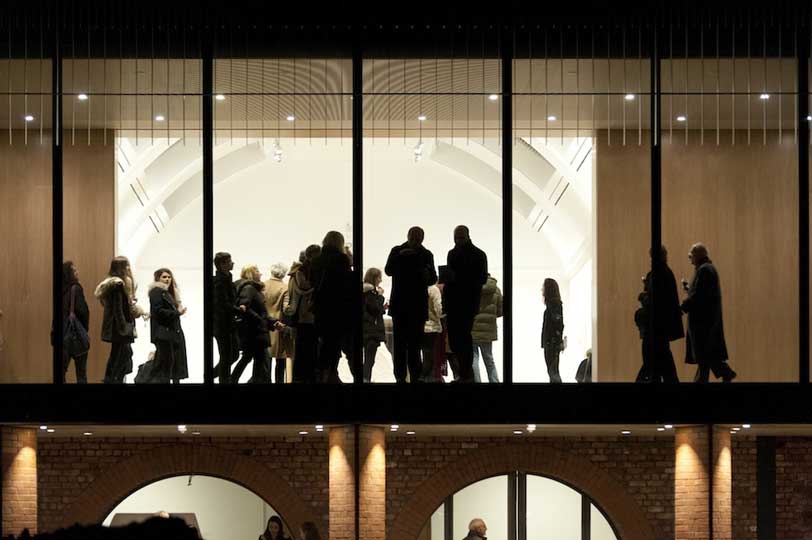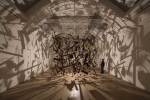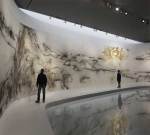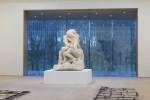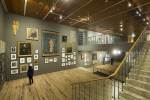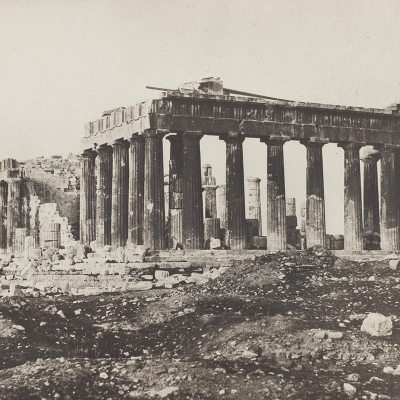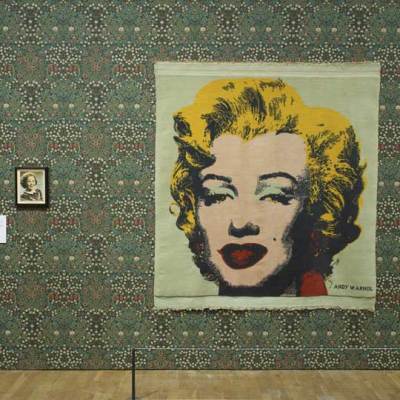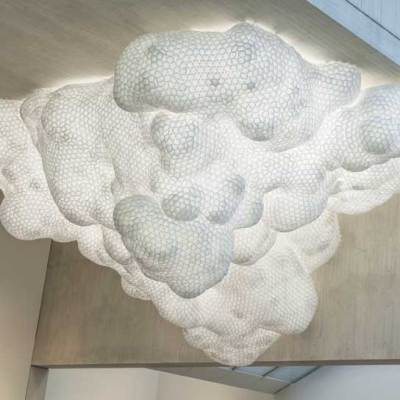IDEALLY HERE
A BEAUTIFUL LARGE
FIREPLACE WHERE
WE COULD ALL
GATHER
Laure Prouvost’s slogan, placed below a staircase at the newly reopened Whitworth Art Gallery in Manchester, is a playful homage to sepia-tinged Victorian values. The building’s original façade reminds us of such values with gritted, terracotta teeth: favouring the morally grounded architecture of the cultural citadel, it has very little time for Prouvost’s playfulness.
Nonetheless, step inside the Whitworth since its £15 million transformation by MUMA architects, and you’ll find more than just absent fireplaces. Upstairs you’re surrounded by Tits in Space, a wallpaper designed by Sarah Lucas and soon to be seen in every Mancunian sitting room. A permanent installation by David Batchelor entitled Plato’s Disco casts spinning coloured lights above a stone-handled staircase. Cai Gio-Qiang has smeared gallery walls with gunpowder dust and dug a pond in the floor; outside, a sea of mud and stranded construction equipment stand in for a future art garden. At the heart of the newly restored exhibition halls, Cornelia Parker’s exploded shed Cold Dark Matter: An Exploded View (1991) hovers in suspended animation, as if ready to clatter to the floor.
The story of the Whitworth, under the direction of Maria Balshaw, is a real coup for arts funding. With the required £15 million amassed from public and private donors, the original building has been restored, opening the imposing Great Hall to the public and returning the barrel-vaulted 19th-century galleries to their former glory. Meanwhile, an extension in brick, glass and stainless steel increases the space by a third: a seriously snazzy café sweeps forward into the surrounding park, offering a Swiss Family Robinson ‘treehouse’ experience as you drink your coffee. Mutinous murmurs of a ‘café with a gallery attached’ are quickly dispelled by the generosity of the design, which presents an integrated structure sensitively woven between the old and the new – the exterior even features a traditional slash-work effect, inspired by the gallery’s textile collection and rendered in a bespoke ‘Whitworth blend’ of brick. At the centre of the extension, a glass promenade gallery sheds light on the collection, drawing in visitors from the park beyond. What was once a fortress of culture is now a conduit.
But it isn’t all about smooth finishes and easy access. The exhibitions are a patchwork of subtle combinations and complex narratives. Whether you’re strolling through Thomas Schütte’s washing lines of works on paper, Low Tide Wandering (2001), or admiring the portraits spread high on the walls in the style of an 18th-century salon, the hang invites the visitor to create their own associations. This style of curation comes into its own in Cornelia Parker’s solo show, which headlines the opening programme. As well as presenting a number of well-known works and new commissions, Parker had a hand in arranging the Whitworth’s famous watercolour collection, bequeathed by the Victorian media magnate John Edward Taylor. Look carefully at the densely packed display of watercolours by Blake, Turner and Cozens and you’ll see three faint works on paper, each contained within a white frame. These are blottings of Turner paintings discovered by Parker during her work with Tate conservators, an extension of her series Room for Margins (1998). As marginalia is allowed to seep into the established canon, Parker makes sure that we give space to trace.
MUMA’s enlightened redesign has inspired an ambitious style of curation and programming: generous spaces and open sightlines allow a new freedom for both the visitor and the gallerist. It remains to be seen whether other major programmes of redevelopment, such as the York Art Gallery which reopens this summer, will have the same success.
Cornelia Parker’s solo show is at the Whitworth Art Gallery, Manchester, until 31 May; dates of other exhibitions vary.
Related Articles
Diary: The Whitworth Art Gallery (Maria Balshaw in the February issue of Apollo)
